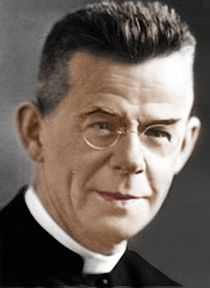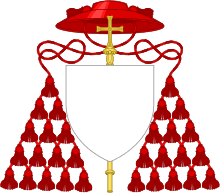Joseph Cardijn
| His Eminence Joseph Cardijn Servant of God | |
|---|---|
| Cardinal-Deacon of San Michele Arcangelo | |
 | |
| In office | 25 February 1965 – 24 July 1967 |
| Predecessor | None: titular church created |
| Successor | Javier Lozano Barragán |
| Orders | |
| Ordination | 22 September 1906 |
| Consecration |
21 February 1965 by Leo Joseph Suenens |
| Created Cardinal |
22 February 1965 by Pope Paul VI |
| Rank | Cardinal-Deacon |
| Personal details | |
| Birth name | Joseph Leo Cardijn |
| Born |
13 November 1882 Schaerbeek, Brussels, Belgium |
| Died |
24 July 1967 (aged 84) Leuven, Vlaams-Brabant, Belgium |
| Previous post | Titular Archbishop of Tusuros (1965) |
| Motto | Evangelizare pauperibus ("To evangelize the poor") |
| Sainthood | |
| Venerated in | Roman Catholic Church |
| Title as Saint | Servant of God |
| Styles of Joseph Cardijn | |
|---|---|
 | |
| Reference style | His Eminence |
| Spoken style | Your Eminence |
| Informal style | Cardinal |
Joseph Leo Cardijn (13 November 1882 – 24 July 1967) was a Belgian cardinal of the Roman Catholic Church and was the founder of the Young Christian Workers.
Biography
Early life
Joseph Cardijn was born in 1882 in Schaerbeek, Belgium, the eldest son of Henri Cardijn and Louise Cardijn, née Van Daelen. He lived with his grandparents in Halle until his parents quit their job as caretakers and his father started business as a coal merchant, while his mother opened a café. Both deeply Christian, they agreed to let Joseph continue his studies to become a priest instead of going to work in the factory.
Priesthood
After studying at the College of Our Lady in Halle, Joseph went in 1903 to the Mechelen seminary. On 22 September 1906, he was ordained priest.[1] By then, influenced by his parents and by his fellow priest Adolf Daens, he had decided to spend his life bringing Christianity back to the working class.[2]
He became a teacher in Wavre, and travelled abroad in the holidays, meeting people like Baden Powell and Ben Tillett. In 1912, after being ill, he was appointed to the parish of Laeken near Brussels, where he started creating and improving workers' organizations in earnest. Twice imprisoned during World War I for so-called patriotic activities, he left Laeken in 1919 and devoted his time solely to social work from then on. The same year, he started the "Young Trade Unionists". At first these met resistance from within the Catholic Church, but after a while the organization and Cardijn became accepted, and in fact Cardijn received a blessing from Pope Pius XI in 1925.[1]
In 1924, the name of the organization was changed to "Jeunesse Ouvrière Chrétienne", the Young Christian Workers.[1] JOC grew rapidly throughout the world; its members were often known as "Jocists" (the movement was often called "Jocism"). By 1938, there were 500,000 members throughout Europe;[3] in 1967, this had increased to 2,000,000 members in 69 countries.[4]
Cardinalate and death
On 12 February 1965, Pope Paul VI announced that he would create Cardijn a cardinal;[5] on the 15th Cardijn was appointed a bishop in anticipation of his elevation to the cardinate. Leo Joseph Cardinal Suenens consecrated him as the Titular Archbishop of Tusuros on 21 February 1965, and the next day Cardijn was elevated to the cardinalate as the Cardinal-Deacon of San Michele Arcangelo.[6]
Cardijn died of kidney complications in 1967.
Beatification process
The official cause of canonization was opened in January 2014 with the commencement of an inquiry into his life.
Legacy
In addition to Young Christian Workers, Joseph Cardijn's See, Judge, Act model influenced a number of lay movements around the world, including Young Christian Students, Student Catholic Action, Paulian Association, Young People for Development and Palms Australia.
In North America during the 20th Century, Cardijn's approach was applied in Catholic Action movements including the Young Christian Workers, the Christian Family Movement, and Friendship House by such leading Roman Catholic chaplains as Louis J. Putz and Reynold Henry Hillenbrand.
The model has been popularly adopted in South America as a practical tool compatible with Liberation Theology, being used higher up the Catholic hierarchy than in other regions.[7]
In Noarlunga Downs, South Australia, Cardijn College which is a Catholic Secondary School has been named in his honour. The school's motto is adopted from Cardijn's model.
In South Africa it was used, via the Catholic Church, to support the development of the first black trade unions in Durban in the early 1970s.[8]
External links
- Biography of Cardijn on the Irish Young Christian Workers website
- A boy from Flanders – The life of Joseph Cardijn
Notes
| Wikimedia Commons has media related to Joseph Cardijn. |
- ↑ 1.0 1.1 1.2 "Biography at". Catholicauthors.com. 22 September 1906. Retrieved 2 March 2013.
- ↑ "Biography at". Belgium.be. Retrieved 2 March 2013.
- ↑ iPad iPhone Android TIME TV Populist The Page (26 September 1938). "Time magazine article from 1938". Time.com. Retrieved 2 March 2013.
- ↑ iPad iPhone Android TIME TV Populist The Page (26 September 1938). "Obituary in Time magazine, 1967". Time.com. Retrieved 2 March 2013.
- ↑ "Young Christian Workers' biography of Cardijn". Ycw.ie. Retrieved 2 March 2013.
- ↑ "Joseph-Léon Cardinal Cardijn". Catholic-Hierarchy.org. David M. Cheney. Retrieved 23 January 2015.
- ↑ "Report on Latin American bishops' communication with the Pope". Clericalwhispers.blogspot.com. 13 June 2007. Retrieved 2 March 2013.
- ↑ Ian Macqueen, PhD Thesis (2011). "Re-imagining South Africa: Black Consciousness, radical Christianity and the New Left, 1967 – 1977". University of Sussex.
|